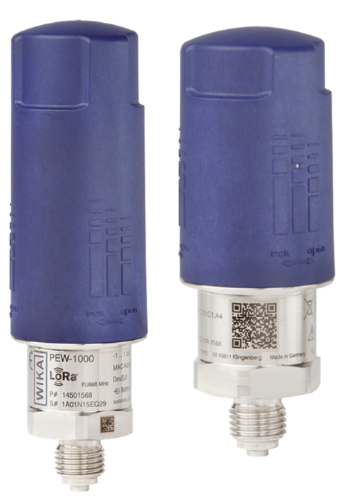PEW-1x00

Description of the device
The model PEW-1x00 is a radio-based pressure sensor for monitoring liquids and gases. It uses the licence-free LoRaWAN® and Bluetooth® radio standards and is used, for example, on mobile equipment and remote measuring points. Thanks to intelligent measurement and transmission control and a replaceable battery, the sensor can be operated for years without maintenance. The intelligent configuration allows measurement and transmission intervals that are dependent on the measured value. In addition, the sensor can measure continuously without transmitting every measured value. This means: high safety with low data and energy consumption. All data is available digitally in a cost-efficient way and allows automated analyses. Thanks to numerous process connections and the two available standards − LoRaWAN® for the kilometre range and Bluetooth® for the metre range − the pressure sensor can be flexibly configured. Via retrofit, machinery or moving parts can be configured smartly − without having to plan and document cable routing. Particularly when no continuous measurement is needed, cost advantages can be realised. The model PEW-1x00 is built to be robust and shockresistant. Thanks to IP65, it is well protected against dust and splash water. The battery is preassembled and can be replaced easily. It is not necessary to replace the entire pressure sensor. The sensor enables simple condition monitoring. A temperature indication, in addition to the pressure value, reveals possible malfunctions due to wear or system faults at an early stage and thus reduces the risk of downtime and damage.
For more information see product site.
PEW Parser Quick Start
Parser API
All functions are pure (no global mutation) except setMeasurementRanges which updates internal range configuration for subsequent decodes.
Types:
Input types:
interface UplinkInput {
fPort: number // LoRaWAN FPort
bytes: number[] // Raw payload as array of unsigned bytes (0-255)
recvTime?: string // Optional ISO timestamp (if your LNS provides it)
}
interface HexUplinkInput {
fPort: number // LoRaWAN FPort
bytes: string // Raw payload as hex-encoded string (case-insensitive, even length)
recvTime?: string // Optional ISO timestamp (if your LNS provides it)
}Return type (shared by all decode helpers):
type Result = {
data: Record<string, any> // Parsed key/value pairs
warnings?: string[] // Non-fatal anomalies
} | {
errors: string[] // Fatal or structural issues only
}To understand the data field, take a look at the examples and the schema definition.
Supported channels to identify different sensors by:
// Is used in the returned data
type ChannelName = 'pressure' | 'device temperature'Channels that support adjusting the measurement range:
type AdjustableChannelName = 'pressure'decodeUplink(input)
function decodeUplink(input: UplinkInput): ResultdecodeHexString(hexInput)
function decodeHexString(hexInput: HexUplinkInput): DecodeResultbytes must have even length; case-insensitive.
setMeasurementRanges(channel, range)
// Will throw on invalid channel name
function setMeasurementRanges(
channelName: AdjustableChannelName,
range: {
start: number
end: number
}
): voidApplies to future decodes only.
adjustRoundingDecimals(decimals)
// Smartly adjust number of decimals for rounded values
// Impacts all numeric values in all outputs
// Default is 4
function adjustRoundingDecimals(decimals: number): voidApplies to future decodes only.
Quick Start
Some network servers may not conform to the LoRaWAN codec specification. In this case, you need to create a small wrapper function.
Your device ranges might not be the default. Insert your desired ranges before decoding like this:
// Parser code...
// Quick start guide...
setMeasurementRanges('pressure', { start: 0, end: 100 })NPM Module Inclusion
| Device | Included | Factory function |
|---|---|---|
| PEW | ❌ | ❌ |
